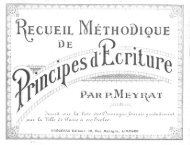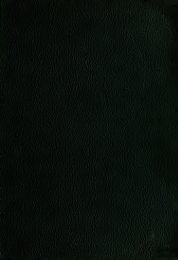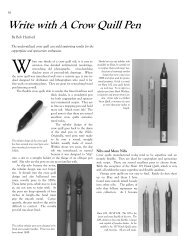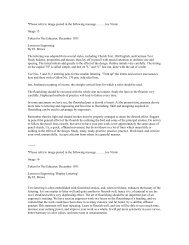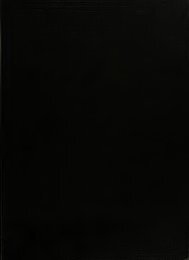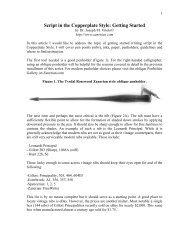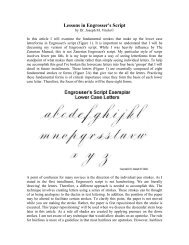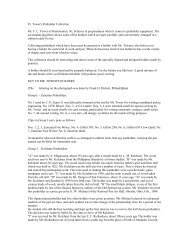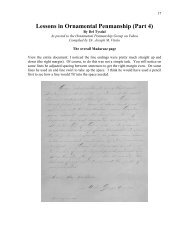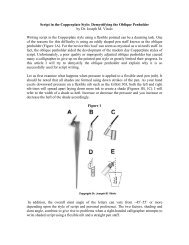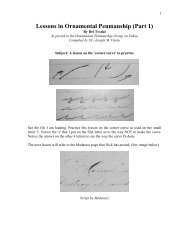The Educator (Volume 45) - IAMPETH
The Educator (Volume 45) - IAMPETH
The Educator (Volume 45) - IAMPETH
Create successful ePaper yourself
Turn your PDF publications into a flip-book with our unique Google optimized e-Paper software.
14<br />
<strong>The</strong> earliest known records in the<br />
form of writing are the inscriptions<br />
on tablets of baked clay, which were<br />
excavated from the ruins of the ancient<br />
Chaldean city of Nippur. Such<br />
tablets were probably in use about<br />
6000 B. C. This form of writmg is<br />
known as Cuneiform writing. It appears<br />
to have been originally inscribed<br />
upon a vegetable substance<br />
called "likhuse," but the abundant<br />
clay of the country afforded material<br />
whose convenience and permanence<br />
brought it into general use. Upon<br />
this the characters were impressed<br />
by a reed or square-shaped stylus;<br />
the clay-books being afterwards<br />
baked or sun dried. For inscriptions<br />
on metal or stone a chisel was used.<br />
This system of writing originated<br />
in Babylonia at a remote and unknown<br />
date. It was invented by a<br />
primitive race of people called Sumerians<br />
who developed it from a<br />
crude form of picture writing. It<br />
was adopted by the Semetic Babylonians<br />
about <strong>45</strong>00 B. C. Cuneiform<br />
writing was taken over by the Assyrians<br />
and Egyptians and was in<br />
use until the first century before the<br />
Christian Era.<br />
Each sign employed consists of a<br />
wedge or a combination of wedges<br />
wi-itten from left to right. <strong>The</strong><br />
wedge points to the right, downward<br />
or aslant, and sometimes two wedges<br />
are joined to form an angle. Cuneiform<br />
writing is difficult to translate,<br />
because a character may represent<br />
a whole syllable or a word. This<br />
system, therefore, is extremely difficult.<br />
Picture writing is one of the earliest<br />
form of writing. In a study of<br />
the cave man we find him as a signmaker.<br />
His prehistoric remains supply<br />
evidence of artistic capacity in a<br />
remote past and set before us in<br />
vigorous, rapid outline, what his life<br />
must have been, on fragments of<br />
bone, horn, schist, and other materials.<br />
Very simple pictures are drawn<br />
upon birch bark indicating by their<br />
order the subjects in a series of songchants<br />
with sufficient precision to<br />
enable the singer to recall the theme<br />
of each in his recitation. An account<br />
can be kept of sales or purchases by<br />
representing in a perpendicular stroke<br />
the number of each series by a picture<br />
of the animals or objects to<br />
which the series refers. Thus, three<br />
strokes followed by the picture of a<br />
deer indicates that the hunter has<br />
brought three deer for sale.<br />
Indication of man's presence remains<br />
rare, since only pictographs<br />
on some durable material, or specimens<br />
of the fictile art, would survive<br />
the action of time. To those<br />
yielded by the bare carvers already<br />
History of Handwriting<br />
OTTIE CRADDOCK<br />
A composite report of a study<br />
made by a group of students at<br />
Farmville State Teachers College.<br />
referred to are to be added rock<br />
carvings in Denmark, and figures on<br />
limestone cliffs of the Maritime Alps.<br />
Picture writing was one important<br />
way of communicating among the<br />
Indians. <strong>The</strong> heroic deeds of the<br />
warriors were inscribed upon the<br />
walls of his tepee. Everyone would<br />
then know how much recognition to<br />
give him. <strong>The</strong> pigments were minerals<br />
in argon, mixed with water, and<br />
applied with a stick.<br />
<strong>The</strong> Calendar of the Indians relates<br />
to us narratives extending over<br />
many years. A particular calendar<br />
of the Dakotas represents the period<br />
from 1799 to 1870. <strong>The</strong> narrative<br />
is written in a spiral form, beginning<br />
in the center and reading outward.<br />
<strong>The</strong> first entry in this calender<br />
consists of three rows of lines<br />
indicating that in 1799 thirty Dakotas<br />
were killed by the Crows. <strong>The</strong><br />
story of this tribe unfolds in order.<br />
<strong>The</strong> Dakotas stole horses with shoes;<br />
Good penmanship is always<br />
legible, otherwise it fails of its<br />
main purpose. When writing,<br />
take thought for the reader.<br />
Clara H. Morris.<br />
—<br />
they stole horses with curly tufted<br />
hair; they had a medicine dance and<br />
went to war, as shown by the pipe<br />
stem ornamented by feathers; Crow<br />
Indians killed eight Dakotas; a Dakota<br />
killed another Indian, as he was<br />
about to shoot an eagle; and so on<br />
through the years. Thus we see that<br />
the Indians could do quite a bit of<br />
writing in pictures only.<br />
<strong>The</strong> Indians had no way to send<br />
written messages. This disadvantage<br />
was greatly overcome by the<br />
use of signals. <strong>The</strong> great distance<br />
of the open country required signals<br />
of several kinds. Perhaps there was<br />
an enemy in the offing; perhaps there<br />
were wild horses and the distant<br />
tribe must be given information. <strong>The</strong><br />
signals were given by the watcher,<br />
who stood erect on a hill, with his<br />
face toward the camp, holding his<br />
blanket with an end in each hand,<br />
his arms being stretched out, right<br />
and left, on a line with his shoulders.<br />
Most American Indian tongues may<br />
be called "holophrastic," from the<br />
practice of compressing a whole sentence<br />
into a word. <strong>The</strong> length of<br />
the sentence is sometimes very remarkable.<br />
As an example may be<br />
given the Micmac "Yaleoolemaktawepokwase"<br />
meaning, "I am walking<br />
about carrying a beautiful black umbrella<br />
over my head."<br />
In comparatively recent times the<br />
Dakota Indians invented a chronological<br />
table or winter court, wherein<br />
each year is recorded by a picture of<br />
some important event which befell<br />
during that year. In these pictures a<br />
considerable amount of symbolism<br />
was necessary. A black upright stroke<br />
indicated that a Dakota Indian was<br />
killed. A rough outline of the head<br />
and body spotted with blotches indicated<br />
that in that year the tribe<br />
suffered from smallpox. Sometimes<br />
in referring to persons, the symbol<br />
is of the nature of a rebus. Thus<br />
Red Jacket, an Indian chief, was<br />
killed in the year of 1807-8. This<br />
fact was recorded by a red coat with<br />
two arrows in it, and blood dripping.<br />
<strong>The</strong> Rosetta Stone gave to the<br />
world the key to the translation of<br />
the long lost ancient Egyptian language<br />
and made possible the extensive<br />
modern study of the history of<br />
the Nile Valley and its people,<br />
through ancient literature. <strong>The</strong> stone<br />
is inscribed with a decree of the<br />
Egyptian priesthood, which had assembled<br />
at Memphis in 195 B. C. This<br />
decree, issued in honor of Ptolemy V.<br />
Epiphanes (205-181 B. C), was written<br />
in hieroglyphics, or picture writing,<br />
and in Greek; also in demotic, a<br />
simplified form of Egyptian writing.<br />
Scholars were able to decipher the<br />
Egyptian texts by comparing them<br />
with the Greek. In this way, they<br />
found the clue to the hidden characters<br />
of the language of the ancients.<br />
Chief honor for the discovery of the<br />
clue is due Francois Champollion, a<br />
French Egyptologist.<br />
<strong>The</strong> Rosetta Stone, now in the<br />
British Museum, is composed of black<br />
basalt. It was found near Rosetta,<br />
Egypt, in 1799 by a French officer<br />
of Napoleon's engineering corps.<br />
Parts have been broken away, and<br />
at present it is three feet nine inches<br />
in height, eleven inches in thickness,<br />
and two feet four and one-half inches<br />
in breadth.<br />
Hieroglyphics applied by the<br />
Greeks to the symbols carved by the<br />
Egyptians on their monuments. Presumably<br />
the Egyptian hieroglyphics<br />
were originally pure picture-writing,<br />
but the gap between that and the<br />
combination of ideograms with phonetic<br />
symbols must be bridged by<br />
imagination, for the earliest inscriptions<br />
extant, which date perhaps<br />
from 5000 B.C., contain both forms.<br />
Some of the symbols yield their



